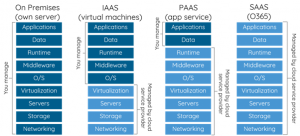NW Computing manages and optimises cloud environments for hundreds of companies across Australia and New Zealand.
What is Microsoft Azure?
Microsoft Azure is the largest cloud globally, made up of an ever-increasing number of services available from any of Microsoft’s 50+ global Azure regions, including 4 within Australia.
Microsoft are currently spending over a billion dollars a month on cloud development – adding to their IaaS (Infrastructure as a Service), PaaS (Platform as a Service) and SaaS (Software as a Service) technology catalogue. Cloud adoption is not a one off task – it’s a continuing evolving project as technology changes.
Microsoft Azure break down their services into three key areas:
Infrastructure as a Service (Iaas) is hardware infrastructure which can be provisioned instantly and managed for you in the cloud by the service provider, in this case Microsoft Azure.
Platform as a Service (Paas) is hardware infrastructure, and the operating system which can be provisioned instantly and managed for you in the cloud by the service provider, in this case Microsoft Azure.
Software as a Service (SaaS) is hardware infrastructure, operating system, and application which can be provisioned installed and managed for you in the cloud by the service provider, in this case Microsoft Azure.

Why move to Microsoft Azure?
Moving to Azure doesn’t need to be a scary or risky process. Your existing network can be extended to Azure, allowing you to leverage cloud technology for redundancy or a particular application. Generally speaking there are four main drivers for cloud adoption:
Security
Australian businesses now have a clear legal obligation to meet minimum IT security standards. Buying and maintaining enterprise-grade firewalls, a separate backup or DR location, data loss prevention and multi-factor authentication infrastructure, and continually adapting to new and emerging threats can make is cost prohibitive to adequately protect your business data using traditional on-premise methods.
Microsoft detect and block approximately 1.5 millions attempts a day to gain access to their infrastructure. They take responsibility for providing the most reliable and secure infrastructure, and include things like machine learning and intelligent threat analysis. Through Azure these tools are available cost-effectively, and with no capital investment.
Additionally, any workloads can be replicated across Azure’s 50+ regions to ensure your data is safe and meets the most stringent data security and availability obligations.
In April 2018 Microsoft Azure and Office 365 were awarded Protected Certification by the Australian Signals Directorate – the only global public cloud provider to meet the security standards for storing and handling Protected data.
Cost
With on-premise infrastructure, you pay an upfront cost for the hardware, and an upfront or ongoing cost for things like licensing and warranty. The harder costs to track are setup, maintenance and support, facility cost (even if just a room in your offices), and power and cooling costs. Additionally, as hardware typically lasts for 3-5 years you need to buy for your future needs, which often means over-catering in terms of functionality and user counts.
With cloud computing such as Azure, resources are charged either by the hour, or by usage (e.g. volume of data stored). This cost includes licensing and all the underlying hardware requirements.
It’s no secret that economies of scale can introduce huge savings – and with its global scale, Microsoft does exactly that with Azure, meaning that costs are often far less than with your own hardware.
Reliability
IT infrastructure professional are only half joking when they say that no-one notices when they keep everything running – but everyone sure knows about it whenever anything breaks. The cost of downtime for a business can be huge – how long would your customers be patient for if you couldn’t communicate with them, or access any data, or do your day-to-day tasks?
Any single point of failure will eventually fail. If your IT infrastructure is on premise and relies on a single piece of infrastructure, power source, cooling system, etc. – one day that point of failure will be yours.
Azure doesn’t promise that its servers won’t fail – quite the opposite, it highlights the fact that can and will. What it does do is provide the tools to deploy your critical applications across multiple servers, in multiple regions – so that when that failure does occur, you’re able to stay operations.
NW Computing deploys infrastructure using best practice methods including Availability Sets and Load Balancing to further increase the uptime of your infrastructure.
Scalability
IT should help a business grow – not be a constraint. With cloud, the word ‘elasticity’ is often used – to represent the ability for computational resources to expand and contract as required by the business.
This could be coping with rapid growth, or the Christmas surge for retail, or the tax time rush in finance, or even monthly data operations for analytics. NW Computing can optimise Azure to automatically change its assigned resources depending on the workload.